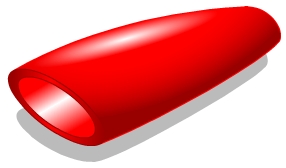Introduction
Gas assisted injection moulding (GAIM or GAM) process is used to produce hollow, lightweight plastic products. The process involves partially filling a mould with molten polymer then injecting nitrogen gas into a mould. The gas forces the molten plastic against the sides of the mould and holds the plastic until it cools and solidifies.
The injection moulding process is as follows:
- polymer powder or granules are fed into a heated injection moulding machine
- the polymer is melted in the injection moulding machine
- a measured amount of polymer is injected into the mould
- nitrogen gas is injected into the mould so that the gas forces the molten polymer against the internal sides of the mould.
There are two methods of injecting nitrogen gas, either into the molten polymer or between the polymer and one side of the mould. |
| |
|
Click on the screenshot above to view the "Gas Assisted Injection Moulding (internal)" animation by Laszlo Lipot |
An image showing the Flash animation logo  is a
link to a Flash animation. is a
link to a Flash animation.
Flash animations are embedded into the pages of all my D&T Modules but there are pictorial links to the animations on this web site so that devices that cannot play Flash animations will at least show a jpeg screenshot of the animation.
If your PC or personal digital assistant (PDA) can play Flash animations you may click on an image showing the Flash animation logo  to view the animation in a new window. to view the animation in a new window.
(Your browser may require you to click "Allow Blocked Content" to view the animation). See info about viewing Flash animations. |
|
| |
Gas Assisted Injection Moulding (Internal Method)
The internal gas assisted injection moulding process follows this sequence of operations:
- molten polymer is injected into the mould until the mould is about 70% full of polymer
- nitrogen gas is injected into the polymer. The polymer cools and solidifies as it touches the cold sides of the mould. Nitrogen gas passes along the path of least resistance which is the hot, middle part of the polymer. The gas forms a bubble inside the polymer and forces the polymer against the sides of the mould.
- the gas holds the polymer tight against the sides of the mould until it cools
- the gas is released from the mould
- the mould is opened and the moulded product is ejected
This method of gas assisted injection moulding produces hollow plastic products. The method is used because:
- the polymer picks up every detail in the mould
- less polymer is used to make the product, typically between 20% and 50% saving in material
- products are lighter because there is less material
- products cost less to produce because less material is used
- hollow parts are structurally strong and rigid due to the box section structure
- shrinkage marks and warping are eliminated as the gas holds the polymer firmly against the sides of the mould until it cools and solidifies.
|
| |
|
Click on the screenshot above to view the "Gas Assisted Injection Moulding (external)" animation by Laszlo Lipot |
Gas Assisted Injection Moulding (External Method)
The external gas assisted injection moulding process follows this sequence of operations:
- molten polymer is injected into the mould until the mould is full of polymer
- nitrogen gas is injected under pressure between the molten polymer and the mould. The gas forms a thin bubble between the polymer and the mould, forcing the polymer against the opposite side of the mould
- the gas holds the polymer tight against the sides of the mould until it cools
- the gas is released from the mould
- the mould is opened and the moulded product is ejected.
This method of gas assisted injection moulding produces mouldings that:
- pick up the detail on one side of the mould only
- shrinkage marks and warping are eliminated as the gas holds the polymer firmly against the side of the mould until it cools and solidifies.
Polymers typically used for gas assisted injection moulding
Polymers typically used for gas assisted injection moulding are
- Polypropylene (PP)
- Polyethylene (PE)
- Acrylonitrile-butadiene-styrene
(ABS)
- Polycarbonate/Acrylonitrile-butadiene-styrene (PC/ABS)
- Polycarbonate (PC)
- Polystyrene (PS)
- Polyvinyl Chloride (PVC)
Typical products made by gas assisted injection moulding
Products made by internal gas-assist injection moulding have solid skins and hollow cross sections.

Typical products made by gas assisted injection moulding include:
- handles
- automobile trim
- automobile instrument panels and other large sheet-like structural parts with a built-in gas-channel network
- TV cabinets
- shower heads
- plumbing fittings
- tube-like parts
|
| |
|
| |
| Click here to view the PDF version of this resource. |

|
|